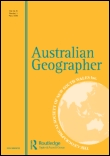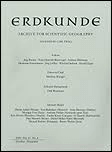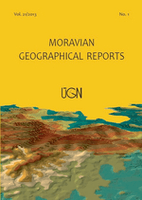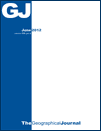
AUSTRALIAN GEOGRAPHER
Scope & Guideline
Connecting Scholars Through Geographic Inquiry
Introduction
Aims and Scopes
- Environmental Geography and Sustainability:
The journal frequently addresses topics related to environmental change, sustainability practices, and ecological justice, reflecting a commitment to understanding how human activities impact natural systems. - Urban Studies and Planning:
Publications often explore urban dynamics, planning, and the experiences of marginalized communities in urban settings, highlighting issues of social justice and equity in city development. - Cultural and Social Geography:
The journal examines identity, place-making, and the cultural dimensions of geography, including indigenous perspectives and the experiences of diverse communities within Australia. - Mobility and Migration Studies:
Research on mobility patterns, migration dynamics, and their implications for communities and regions is a significant focus, addressing contemporary challenges such as refugee settlement and transnational migration. - Regional Development and Change:
The journal contributes to discussions on regional development, demographic changes, and the socio-economic factors affecting various Australian regions, particularly in light of recent events like the COVID-19 pandemic.
Trending and Emerging
- Climate Change and Environmental Justice:
Recent publications emphasize the intersection of climate change with social justice, exploring how marginalized communities are disproportionately affected and how policies can address these inequities. - Urban Resilience and Smart Cities:
There is a growing focus on urban resilience, smart city initiatives, and innovative urban planning strategies that promote sustainability and community engagement in city development. - Mobility Justice:
The concept of mobility justice has gained traction, with studies exploring the implications of mobility for social inclusion and the rights of various populations, including refugees and indigenous communities. - Indigenous Perspectives and Rights:
Research increasingly incorporates indigenous knowledge systems and rights, reflecting a broader recognition of the importance of indigenous voices in geographical scholarship. - Post-Pandemic Urban Studies:
The impact of the COVID-19 pandemic on urban and regional dynamics is a trending topic, with studies addressing shifts in migration patterns, community resilience, and changes in urban living.
Declining or Waning
- Traditional Land Use Studies:
There seems to be a waning focus on conventional land use studies and agricultural geography, as newer themes related to sustainability and urban environments take precedence. - Historical Geography:
Research grounded in historical geography has decreased, possibly due to a growing emphasis on contemporary issues and immediate environmental concerns over historical analyses. - Purely Quantitative Geographic Studies:
There is a noticeable decline in studies that rely solely on quantitative methods without qualitative insights, as the journal increasingly values interdisciplinary approaches that incorporate qualitative data.
Similar Journals

Espaces-Populations-Societes
Advancing Knowledge in Population and GeographyEspaces-Populations-Sociétés is a distinguished journal published by UNIV LILLE I SCI & TECH, focusing on the fields of demography and geography. Established in 1983, this open-access journal has committed itself to providing a platform for innovative research and discussions around population dynamics and spatial organization, with accessibility to its content available since 2004. Based in France, at the UFR Géographie & Aménagement, the journal plays a crucial role in advancing understanding of demographic trends and planning developments. With current Scopus rankings highlighting its position in the 25th and 14th percentiles for Demography and Geography, Planning and Development respectively, it maintains a reputable standing within academic circles, establishing its importance in contemporary research landscapes. Researchers, professionals, and students alike will find valuable insights in its comprehensive overview of sociocultural and environmental interactions, as well as place-based issues at the heart of societal development.

Erdkunde
Advancing Interdisciplinary Insights in GeographyErdkunde is a pivotal academic journal published by the Geographisches Institut, University of Bonn, dedicated to the fields of Geography, Earth and Planetary Sciences, and Ecology. With a history dating back to 1976, this journal serves as a platform for interdisciplinary research and discourse, reflecting diverse perspectives from both theoretical and applied dimensions within these domains. Published in Germany, it currently holds a respectable position within the academic community, classified in Q2 for Geography, Planning and Development and Q3 in Ecology and Earth and Planetary Sciences. Although not an open-access journal, its contribution is significant, offering insights that advance our understanding of spatial dynamics and environmental processes. With Scopus rankings that place it within the median range, Erdkunde is an essential resource for researchers, professionals, and students looking to deepen their knowledge and engage with contemporary trends in geographic research.

Moravian Geographical Reports
Bridging Theory and Practice in Geographical ResearchWelcome to the Moravian Geographical Reports, an esteemed Open Access journal published by SCIENDO, dedicated to advancing the fields of Earth and Planetary Sciences as well as Geography, Planning and Development. Established in 1993, this journal has steadily built a reputation for disseminating high-quality research, evidenced by its 2023 Q2 ranking in both relevant categories and an impressive Scopus percentile ranking of 72. With a dedicated editorial board and an expanding global readership, the Moravian Geographical Reports serves as a vital platform for researchers, professionals, and students alike, fostering dialogue and collaboration across various dimensions of geographical and environmental studies. Since its shift to Open Access in 2013, it has significantly enhanced the accessibility and reach of its published works, making crucial research findings available to a broader audience. The journal continues to thrive as a significant contributor to the geographical and earth sciences discourse during its converged years from 1993 to 2024.

GEOGRAPHICAL JOURNAL
Pioneering research that shapes our understanding of the planet.Geographical Journal, published by Wiley, is a leading scholarly resource dedicated to advancing the field of geography and earth-surface processes. With an established history dating back to 1973, this prestigious journal thrives on disseminating high-quality research, featuring a robust archive that encompasses critical insights from various geographical and environmental studies. As evidenced by its impressive Q1 rankings in both Earth-Surface Processes and Geography, Planning and Development, the journal stands out in its commitment to impact and relevance in the academic community. Although not Open Access, the journal provides researchers, professionals, and students with invaluable peer-reviewed articles essential for understanding complex geographical phenomena. Whether you are focused on socio-environmental interactions or earth sustainability, Geographical Journal serves as a cornerstone for innovative research, fostering knowledge that shapes policy and practice.

Hrvatski Geografski Glasnik-Croatian Geographical Bulletin
Empowering Research with Timely Geographical InsightsHrvatski Geografski Glasnik-Croatian Geographical Bulletin, ISSN 1331-5854, E-ISSN 1848-6401, is an esteemed open-access journal published by the Croatian Geographical Society that has been serving the geography community since 1929. Based in Zagreb, Croatia, this journal focuses on a broad spectrum of geographical research, providing a platform for the dissemination of original articles, reviews, and case studies that contribute to the understanding of earth-surface processes and development planning. Although it currently holds Q4 rankings in both Earth-Surface Processes and Geography, Planning and Development, the journal is dedicated to enhancing its impact within the scientific community, aspiring to elevate research visibility and collaborative opportunities. With a commitment to open access, it ensures that all content is readily available to researchers, professionals, and students worldwide, fostering an inclusive environment for geographical scholarship. Engaging with this journal presents an opportunity to stay updated with emerging trends and pivotal studies within the discipline throughout its converged years from 1998 to 2024, making it a vital resource in geography and related fields.

Letters in Spatial and Resource Sciences
Transforming Ideas into Solutions for Spatial IssuesLetters in Spatial and Resource Sciences, published by Springer Heidelberg, is a prestigious journal dedicated to the interdisciplinary exploration of spatial and resource-related issues within the fields of demography, economics, geography, planning, and urban studies. Since its inception in 2008, this journal has provided a platform for cutting-edge research, facilitating the exchange of innovative ideas and methodologies that address contemporary challenges in spatial dynamics and resource allocation. With an impact factor reflecting its robust standing in academic circles (notably ranking Q2 in Demography and Geography, and Q3 in Economics and Econometrics as of 2023), it serves as an essential resource for scholars and practitioners alike. The journal is committed to fostering open dialogue and advancing the understanding of spatial phenomena, making it a vital asset for anyone engaged in these dynamic areas of study. Targeting a diverse audience, from researchers to industry professionals, it aims to enhance scholarly communication and promote evidence-based solutions to spatial and resource dilemmas.

Biblio 3W-Barcelona
Advancing knowledge in library and information science.Biblio 3W-Barcelona is a prominent academic journal published by the Universitat de Barcelona, Servei Publicacions, focusing on the dynamic field of library and information science. Established to foster scholarly communication, this journal provides a platform for researchers, professionals, and students dedicated to the advancement of bibliographic studies and library management. Despite lacking a current impact factor, Biblio 3W-Barcelona is recognized for its commitment to high-quality research and its contribution to the field, making it a valuable resource for those engaged in understanding the complexities of information dissemination in modern society. The journal features original research articles, critical reviews, and case studies that invite varied perspectives within the realm of librarianship. Readers can access its comprehensive body of work freely, enriching their knowledge and fostering practical applications in library science. For submission guidelines and further information, visit their website.

Asian Geographer
Exploring the Dynamics of Geography in AsiaAsian Geographer is a prominent journal published by Routledge Journals, Taylor & Francis Ltd, recognized for its significant contributions to the field of geography, planning, and development. With an ISSN of 1022-5706 and an E-ISSN of 2158-1762, the journal offers a platform for high-quality, peer-reviewed research that addresses vital geographical issues, particularly within the Asian context. The journal's commitment to fostering informed discourse is reflected in its Q2 category ranking in the field of Geography, Planning and Development as of 2023, and its Scopus ranking of #274 out of 821 in the same category, placing it in the 66th percentile. The Asian Geographer serves as an essential resource for researchers, professionals, and students alike, ensuring access to a wealth of knowledge that influences policy and practice. It continues to publish original research and reviews as it converges to present significant developments in geography from 1982 to 1987, 1991 to 1995, and from 2015 to 2024. This journal is vital for anyone looking to deepen their understanding of geographical dynamics in Asia and beyond.

Habitat y Sociedad
Bridging Human Geography and Urban StudiesHabitat y Sociedad is a distinguished peer-reviewed journal published by UNIV SEVILLA, EDITORIAL, that focuses on the intricate interplay between human habitats and societal dynamics. With ISSN 2173-125X, this journal offers a platform for scholarly articles that explore themes related to human geography, urban studies, and the social impacts of environmental changes. As an essential resource for researchers, professionals, and students alike, it promotes interdisciplinary dialogue and advances knowledge in the field of habitat studies. Although specific impact factors and H-index metrics are currently unavailable, the journal is dedicated to ensuring high academic standards and providing open access to its content, fostering a collaborative research environment. Located in the historic city of Seville, Spain, this journal not only supports regional studies but also contributes to global conversations on sustainable habitation and societal development.

Southeastern Geographer
Championing Diverse Perspectives in Geographical ResearchThe Southeastern Geographer is a prominent academic journal published by the Association of American Geographers, dedicated to advancing knowledge in the fields of Earth and Planetary Sciences and Geography, Planning and Development. With an ISSN of 0038-366X and an E-ISSN of 1549-6929, this journal has been a staple in geographical scholarship since its inception, offering a platform for diverse research that spans over four decades, specifically from 1979 to 1994 and then from 1996 to 2024. The journal is currently classified in the Q3 category within its fields, indicating its significant influence in shaping contemporary geographical discourse. Researchers, professionals, and students alike benefit from its rigorously peer-reviewed articles that explore regional studies, environmental issues, and sociocultural dynamics, making it essential for anyone interested in the interconnectedness of geography and society. As a vital resource for advancing geographical education and research, the Southeastern Geographer continues to engage its audience with innovative insights and scholarly contributions.